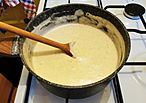French mother sauces facts for kids
In French cuisine, the mother sauces (called sauces mères in French) are a special group of sauces. Think of them as the "parent" sauces from which many other sauces, called "daughter sauces," are made. These main sauces are like building blocks for lots of different flavors!
Chefs have suggested different lists of mother sauces over time. The most common list we use today comes from a famous chef named Auguste Escoffier. He wrote about them in his cookbook Le guide culinaire in 1907.
Here are the main mother sauces:
- Béchamel sauce: This is a white sauce. It's made from milk and thickened with a white roux. A roux is a mix of butter and flour cooked together.
- Espagnole sauce: This is a rich brown sauce. It's made from a brown stock (like beef or veal broth) and thickened with a brown roux. It often includes roasted bones, bacon, and tomatoes.
- Tomato sauce: This sauce is made with tomatoes. It also often has carrots, onion, garlic, butter, and flour. Sometimes, pork belly and veal broth are added too.
- Velouté sauce: This is a light-colored, clear sauce. It's made by cooking down clear stock (from un-roasted bones) and thickening it with a white roux. "Velouté" means "velvety" in French, which describes its smooth texture.
- Hollandaise sauce: This is a warm, creamy sauce. It's made by mixing egg yolk, melted butter, and lemon juice or vinegar. This mix is called an emulsion.
Another important sauce, mayonnaise, is often considered a mother sauce for cold sauces. It's a cold emulsion of egg yolk, oil, and vinegar.
History of Mother Sauces
The idea of "mother sauces" isn't new. It existed long before Chef Escoffier made his famous list. People were talking about main sauces that other sauces came from as early as the 1800s.
Early Ideas by Marie Antoine Carême
In 1833, another famous French chef, Marie-Antoine Carême, wrote about sauces. He called them "great and small sauces" instead of mother and daughter sauces.
Carême listed four "great sauces":
He also listed other sauces, like Hollandaise and Mayonnaise, as "small sauces." This shows that chefs had different ideas about which sauces were the most important.
Escoffier's Influence
Chef Auguste Escoffier helped make the list of mother sauces we know today very popular. His book Le guide culinaire was first published in 1903. In the French versions, he listed Espagnole, Velouté, Béchamel, and Tomate as the main "Grandes Sauces." He saw Hollandaise as a "daughter sauce." He also described Mayonnaise as a mother sauce for cold dishes.
However, the English version of his book, A Guide to Modern Cookery (1907), changed things a bit. It included Hollandaise as one of the five "basic sauces." This is why many people today learn about five or six main mother sauces.
Daughter Sauces
Many different sauces, called daughter sauces, are made from the mother sauces. It's like the mother sauce is the base, and you add other ingredients to create new flavors.
Béchamel Sauce
Béchamel is a creamy, milk-based sauce. It's thickened with a white roux (butter and flour). Chefs often flavor it with onion, nutmeg, or thyme.
Sauces from Béchamel
Espagnole Sauce
Espagnole is a rich, dark brown sauce. It's made from a dark brown roux and brown stock (like beef or veal broth). It often includes tomatoes or tomato paste.
Sauces from Espagnole
- Demi-glace (a very rich, reduced espagnole)
- Poivrade
- Grand veneur
- Bigarade
Velouté Sauce
Velouté is a light-colored sauce with a smooth, "velvety" texture. It's made by cooking down clear stock (from un-roasted bones, like veal, chicken, or fish) and thickening it with a white or blond roux.
Sauces from Velouté
- Allemande (thickened with egg yolks and cream)
- Poulette
- Cardinal
- Poultry velouté (made with chicken stock)
- Fish velouté (made with fish stock)
- Bercy
- Normande
Tomato Sauce
The tomato sauce Escoffier described is a classic. It's made with fatty salted pork, a mirepoix (a mix of carrots, onions, and thyme), and white stock.
Sauces from Tomato
- Bolognaise
- Portugaise
- Milanaise
Hollandaise Sauce
Hollandaise is a warm, creamy sauce. It's an emulsion of egg yolk and clarified butter, flavored with lemon juice or vinegar.
Sauces from Hollandaise
- Béarnaise (with tarragon and shallots)
- Bavaroise sauce
- Crème fleurette
- Maltese sauce
- Noisette sauce
Mayonnaise
Mayonnaise is a cold, thick sauce. It's an emulsion of egg yolk and oil, often flavored with lemon juice, vinegar, and seasonings.
Sauces from Mayonnaise
See also
 In Spanish: Salsa madre para niños
In Spanish: Salsa madre para niños







